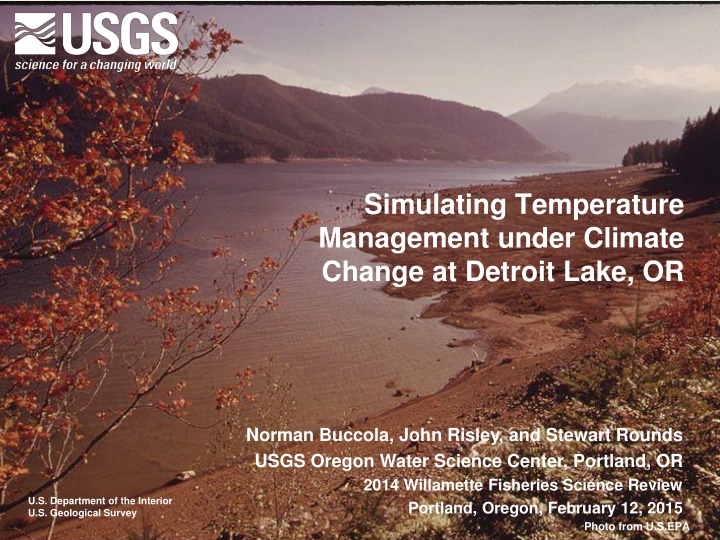
Managing Water Temperature at Detroit Lake under Climate Change
Explore how the operations of Detroit Dam are adapted to modify downstream water temperature amidst climate change effects, particularly in ensuring the habitat of endangered/threatened salmon species remains optimal. The study focuses on simulating temperature management strategies to address the impacts on fish habitat and migration patterns, emphasizing the role of dam operations in mitigating climate change effects on water temperature downstream of the Willamette River dams.
Download Presentation

Please find below an Image/Link to download the presentation.
The content on the website is provided AS IS for your information and personal use only. It may not be sold, licensed, or shared on other websites without obtaining consent from the author. If you encounter any issues during the download, it is possible that the publisher has removed the file from their server.
You are allowed to download the files provided on this website for personal or commercial use, subject to the condition that they are used lawfully. All files are the property of their respective owners.
The content on the website is provided AS IS for your information and personal use only. It may not be sold, licensed, or shared on other websites without obtaining consent from the author.
E N D
Presentation Transcript
Simulating Temperature Management under Climate Change at Detroit Lake, OR Norman Buccola, John Risley, and Stewart Rounds USGS Oregon Water Science Center, Portland, OR 2014 Willamette Fisheries Science Review Portland, Oregon, February 12, 2015 U.S. Department of the Interior U.S. Geological Survey U.S. Department of the Interior U.S. Geological Survey Photo from U.S.EPA
Motivation for Temperature Modeling Endangered/Threatened Salmon What can USACE do to improve water temperature downstream of Willamette dams? Water temperature under future climate: How will current operations work in the future? How to improve conditions? Can dams help mask climate change effects? wikimedia.org
Changed Dam Operations to Modify Downstream Water Temperature Detroit Dam 463 feet tall Multiple outlets: Spillway Power penstocks Upper regulating outlets Lower regulating outlets Temperature affects fish habitat and the timing of migration, spawning, egg incubation and emergence, etc. Warm or cool temperatures accessed with different outlets U.S. Department of the Interior U.S. Geological Survey Photo from U.S. Army Corps of Engineers
Detroit Dam Built in 1953 463 ft tall Uses/Functions: Flood management Hydropower (100MW capacity) Water quality Improvement Irrigation Recreation Fish and wildlife habitat Big Cliff Detroit http://www.nwd-wc.usace.army.mil/nwp/teacup/willamette/
Water Quality Model: CE-QUAL-W2 Corps of Engineers model Lakes, reservoirs, rivers, estuaries 2-D: longitudinal, vertical Dynamic Flow, temperature, water quality DO phytoplankton ammonia phosphorus nitrate detritus alkalinity pH TDS chloride zooplankton dissolved OM sediment OM suspended sediment
Air Temperature Provisional data, subject to revision
Detroit Inflows PRMS percent change Inflow [m3//s] Provisional data, subject to revision
Operational Scenarios curmins Current operating rules* curmins_rc30 Begin refill on Jan 1 lowmins Lower release rates *lower release rates in drought years Structural Scenarios curmins_fl curmins with a hypothetical floating release outlet
Detroit Outflows Provisional data, subject to revision
Detroit Lake Elevation Change Provisional data, subject to revision
Number of Days Above Spillway Altered operations needed to fill reservoir more often and keep full longer Provisional data, subject to revision
Detroit Inflow Temp Provisional data, subject to revision
Detroit Release Temperature Provisional data, subject to revision
Detroit Release Temperature Provisional data, subject to revision
Future Impacts Upstream 23% reduction in annual inflow 1 C increase in mean annual inflow temp Downstream ~1.5 C warming in fall* *using current operational rules Potential Future Temperature Mitigations Begin refill earlier Reduce minimum late-summer releases Hypothetical floating release structure Provisional data, subject to revision
Impacts of Climate Change (Lower+warmer inflows in spring/summer) Operational trade-offs more visible Flood management (spring) Flow augmentation (summer) Hydropower (summer/fall) Lake Elevation Recreation Temperature control
Thanks! Publications to date Simulating Potential Structural and Operational Changes for Detroit Dam on the North Santiam River, Oregon, for Downstream Temperature Management Buccola, N.L., and Rounds, S.A., 2011, Sullivan, A.B., Risley, J.C., 2012 http://pubs.usgs.gov/sir/2012/5231/ Development of CE-QUAL-W2 models for the Middle Fork Willamette and South Santiam Rivers, Oregon Buccola, N.L., Stonewall, A.J., Sullivan, A.B., Kim, Yoonhee, and Rounds, S.A., 2013 http://pubs.usgs.gov/of/2013/1186 Simulations of a Hypothetical Temperature Control Structure at Detroit Dam on the North Santiam River, Oregon Buccola, N.L., Stonewall, A.J., and Rounds, S.A., in press Simulating Future Water Temperature in the North Santiam River, Oregon Buccola, N.L., Risley, J.C., and Rounds, S.A., draft Contact: Norman Buccola - nbuccola@usgs.gov 503-235-3245 John Risley jrisley@usgs.gov 503-251-3279 Stewart Rounds - sarounds@usgs.gov 503-235-3280 Acknowledgements: USACE Portland District: Kathryn Tackley and Dan Turner
